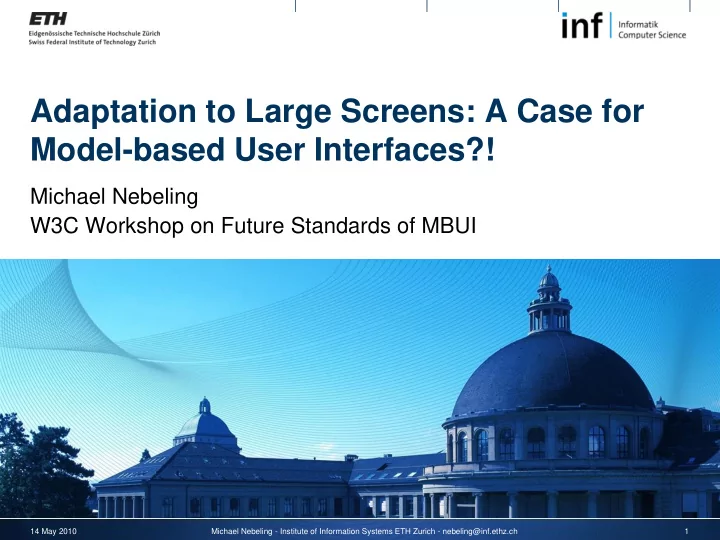

Adaptation to Large Screens: A Case for Model-based User Interfaces?! Michael Nebeling W3C Workshop on Future Standards of MBUI 14 May 2010 Michael Nebeling - Institute of Information Systems ETH Zurich - nebeling@inf.ethz.ch 1
Critique of State-of-the-Art in Web Engineering MDWE approaches (WebML, HERA, UWE, etc.) evolution of the web caused two waves of major model extensions support for context-awareness integration of RIA concepts still document-oriented and page-based changes in the model often require complete regeneration of web application rather limited tool support multi-channel support often results in unmanageable complexity Web application and RIA frameworks (GWT, JavaFX, etc.) often no systematic approach no notion of context and limited (if any) concepts for adaptivity 14 May 2010 Michael Nebeling - Institute of Information Systems ETH Zurich - nebeling@inf.ethz.ch 2
Multi-channel Content Delivery ! ? 14 May 2010 Michael Nebeling - Institute of Information Systems ETH Zurich - nebeling@inf.ethz.ch 3
Problem Scenario: Adaptation to Larger Screens 14 May 2010 Michael Nebeling - Institute of Information Systems ETH Zurich - nebeling@inf.ethz.ch 4
Current Design Issues of Most Web Pages Spatial distribution of content elements mostly static layouts with only limited variability media often loses high proportions of the visible area on first screen amount of visible links often increases substantially at larger viewing sizes Text and font characteristics font weight and size, number of columns and column widths, line spacing often optimised for 1024x768 typically hard-coded Media resources often available only in one size typically embedded with fixed dimensions 14 May 2010 Michael Nebeling - Institute of Information Systems ETH Zurich - nebeling@inf.ethz.ch 5
Recent Work on Quality of UI Adaptations 14 May 2010 Michael Nebeling - Institute of Information Systems ETH Zurich - nebeling@inf.ethz.ch 6
Required Forms of Context-aware Adaptation Content adaptation of web sites must start with adaptation of content varying screen size calls for different versions of text and images e.g. to show only the relevant parts on small screens e.g. to show longer text versions or media with much higher level of detail on large displays Navigation adaptation of content will need to reflect in overall website structure scrolling and attention principles (Jakob Nielsen) scrolling beats paging what is truly important should remain above the fold information foraging theory 14 May 2010 Michael Nebeling - Institute of Information Systems ETH Zurich - nebeling@inf.ethz.ch 7
Required Forms of Context-aware Adaptation (2) Presentation selection of appropriate content elements (possibly versioned in different sizes) effective spatial distribution in the viewport and the style treatment including appropriate font characteristics to support on-screen readability “Although long -standing research exists on grid-based or constraint-based layouts, the specification of rules using native web technologies is still very limited even in the latest versions with HTML5 and CSS3.” current workarounds used by web developers specify adaptive layouts with the help of libraries such as jQuery Masonry using JavaScript and CSS wait until the W3C's proposal to include multi-column layout in CSS3 is adopted and implemented in all major web browsers 14 May 2010 Michael Nebeling - Institute of Information Systems ETH Zurich - nebeling@inf.ethz.ch 8
For MBUI to be applicable, I think we need… Conceptual approaches that interface with existing solutions at the technological level Component-based models that cater for the plug-and-play style and rich interactions in modern web user interfaces Integrated support for design and run-time adaptivity based on first-class context-aware concepts Rich tools that demonstrate feasibility even in complex scenarios such as the adaptation to large screens 14 May 2010 Michael Nebeling - Institute of Information Systems ETH Zurich - nebeling@inf.ethz.ch 9
Recommend
More recommend